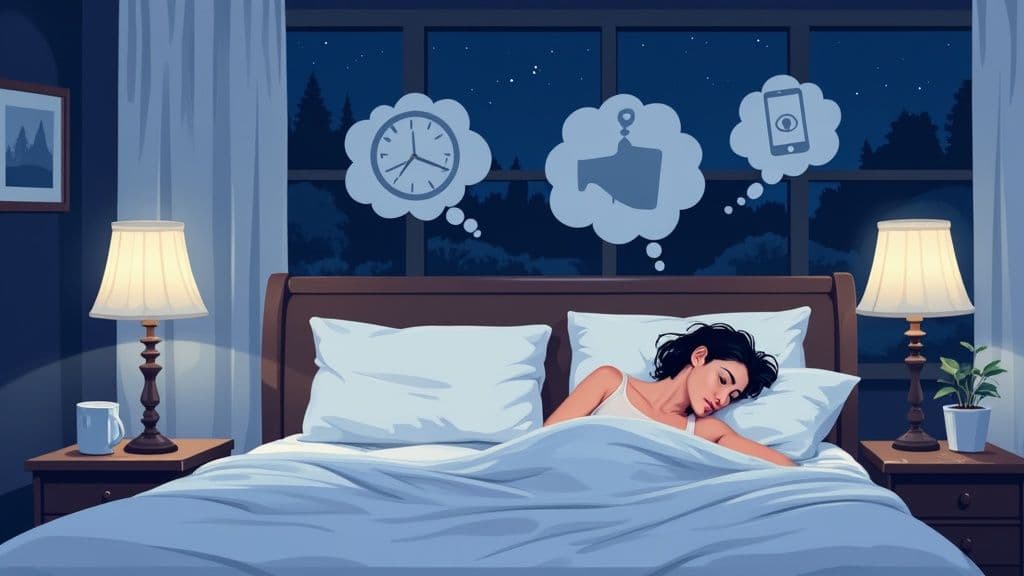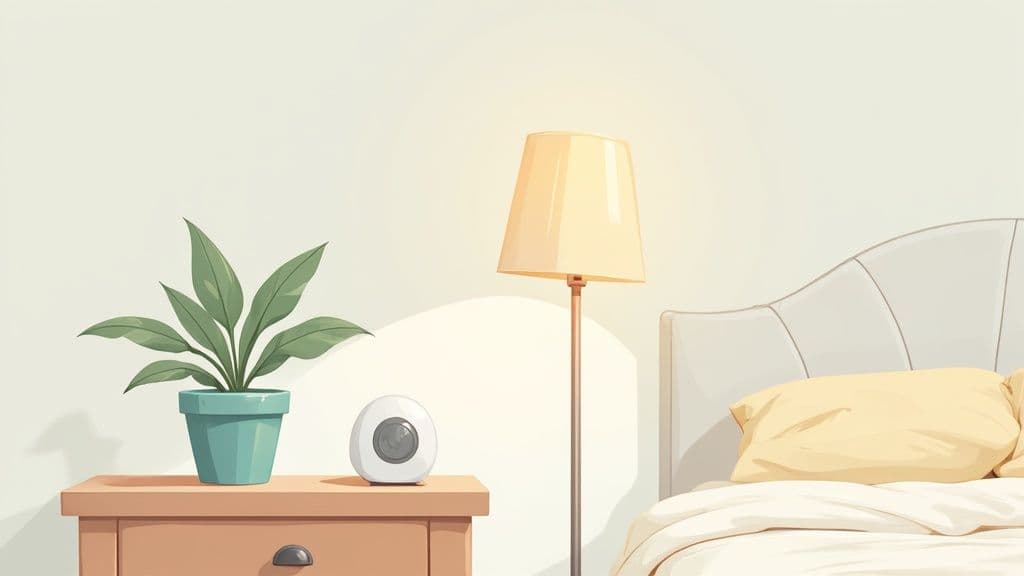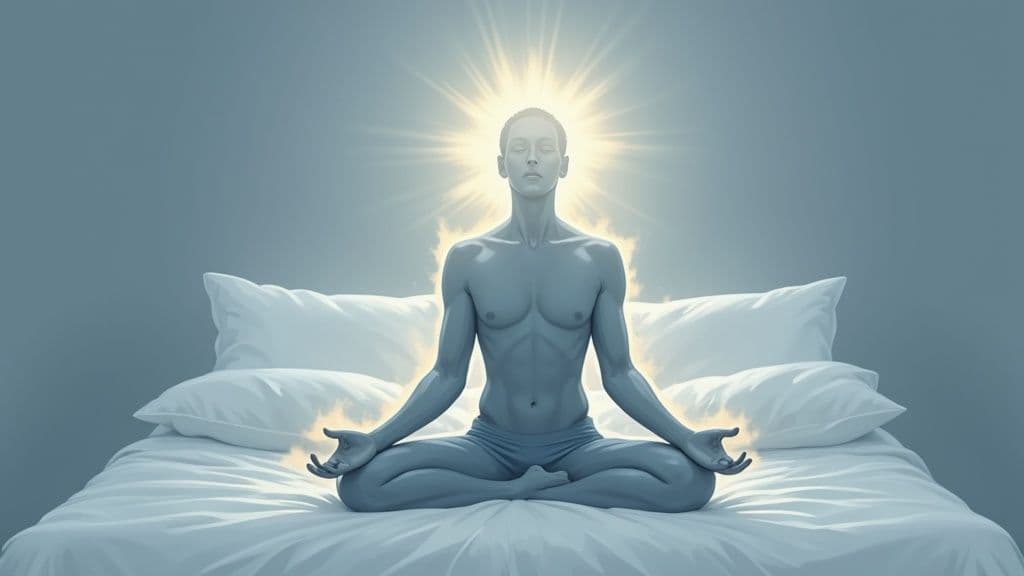Calm Anxiety at Night for Restful Sleep
Tired of a racing mind? Learn practical ways to calm anxiety at night for deep, restorative sleep. Real strategies that work, starting tonight.
To find calm at night, the goal is twofold: you need to quiet your mind and create a genuinely restful environment. This means actively breaking out of anxious thought loops with specific relaxation techniques while also making sure your bedroom signals safety and calm, not more stress.
Why Anxiety Gets So Loud When the Lights Go Out
Ever noticed how your worries seem to crank up the volume the second your head hits the pillow? If so, you're definitely not alone. This is a common experience, and understanding why it happens is the first real step toward reclaiming your nights from anxiety.
During the day, your mind is a busy intersection. You're juggling work, running errands, talking to people, and solving problems. All these activities are natural distractions that push anxious thoughts to the back burner. But when night falls and the world goes quiet, all those distractions vanish. Suddenly, your brain has the open space to fixate on unresolved fears, rehash conversations, and scroll through tomorrow’s massive to-do list.
Your Body and Brain on Nighttime Alert
It’s not just about a lack of distractions, though. There's real physiology at play here. As your body should be preparing for sleep, levels of the stress hormone cortisol are meant to dip. For those of us wrestling with anxiety, that process often gets hijacked. Instead of winding down, your body can stay stuck in a subtle state of "fight or flight," leaving you feeling physically tense and wired.
This kicks off a frustrating, self-feeding cycle:
Anxious thoughts about not being able to sleep keep you awake.
The lack of sleep then makes you even more anxious the next day.
Finally, the memory of a bad night starts to create dread long before you even get into bed.
This whole experience is often called "sleep anxiety"—a specific worry about the inability to fall or stay asleep. It’s a huge modern challenge, particularly for younger generations. In fact, a recent report found that nearly 40% of Generation Z adults struggle with sleep-related anxiety multiple times a week, a trend fueled by modern pressures. You can dig deeper into these findings in the sleep wellness trends report from the Global Wellness Institute.
The core issue isn't that you're "bad at sleeping." It's that your brain has learned to associate bedtime with worry. The key is to unlearn this association by actively creating new, calmer nighttime habits.
Realizing that this is a common—and solvable—problem is the most empowering part. You can learn to manage anxiety at night by tackling both the mental chatter and the environmental triggers that feed it.
Transform Your Bedroom into a Sleep Sanctuary

Your bedroom isn't just a place to sleep; it’s a space that’s constantly sending signals to your brain. When nighttime anxiety hits, it’s often because those signals are ones of stress or wakefulness, not peace. To truly calm your mind, you need to deliberately curate an environment that whispers "rest."
Think about the physical feeling of your room. Is it a bit too warm? Studies have consistently shown that a cooler room, somewhere between 60 and 67 degrees Fahrenheit (15-19°C), is ideal. This simple tweak helps your body's core temperature drop naturally, which is a critical trigger for initiating sleep. It's a small change that can make a surprisingly big difference.
Then there's the noise. That tiny drip from the faucet or the distant hum of traffic can be just enough to keep your nervous system on a low-grade alert. A great counter-strategy is to introduce a consistent, soothing sound. A white noise machine, a simple fan, or an app playing gentle rain sounds can create a predictable "sound blanket," masking those jarring interruptions and helping your anxious mind finally let go.
To help you get started, here's a quick-reference guide to creating an environment that actively works to reduce nighttime anxiety and promote deep, restorative sleep.
Your Bedroom Optimization Checklist
Element | Optimal Setting | Why It Helps Calm Anxiety |
Temperature | Cool (60-67°F / 15-19°C) | Supports the natural drop in body temperature needed to fall asleep. |
Light | Total Darkness | Reinforces your natural circadian rhythm, signaling to your brain it's time for rest. |
Noise | Quiet or Consistent Sound | Minimizes sudden, jarring noises that can trigger a stress response. |
Clutter | Minimal & Organized | Reduces visual "noise" and mental chaos, creating a sense of order and peace. |
Bed Use | Sleep & Intimacy Only | Strengthens the mental link between your bed and rest, not wakeful stress. |
By consciously adjusting these elements, you're not just tidying up; you're actively building a true sanctuary for your mind.
Reclaim Your Bed for Sleep
One of the most powerful things I've learned for tackling nighttime anxiety is a psychological strategy called stimulus control. The idea is brilliantly simple: your bed should be used for only two things—sleep and intimacy. Period.
When you start working from bed, scrolling through your phone, or—worst of all—worrying in bed, your brain builds a strong association between that physical space and a state of wakeful stress. Before you know it, just getting into bed can become the very trigger for your anxiety.
By breaking this habit, you begin to retrain your brain. The goal is to make your bed a powerful cue for rest, so that pulling back the covers signals to your body and mind that it's time to switch off and find peace.
This doesn't mean your entire bedroom is off-limits for relaxation. Try setting up a comfy chair in a corner for reading or listening to music. This creates a dedicated "wind-down zone" that's distinct from your "sleep zone," reinforcing the bed's singular, sacred purpose. This simple boundary can dramatically lessen the anxiety that so often kicks in the moment your head hits the pillow.
Practical Techniques to Soothe a Racing Mind
When anxiety feels less like a thought and more like a physical sensation—that racing heart, a chest that feels too tight, or muscles coiled like springs—you need tools that work directly on your body. This is where simple, powerful relaxation exercises, done right in your bed, become your best allies for calming nighttime anxiety.
The most immediate thing you can control is your breath. When you're anxious, your breathing naturally becomes shallow and quick, which keeps your nervous system stuck on high alert. Intentionally slowing it down sends a direct, undeniable signal to your brain: you are safe.
Master the 4-7-8 Breathing Technique
The 4-7-8 breathing method is a beautifully simple, rhythmic exercise. Think of it as a natural tranquilizer for your nervous system, designed to activate your body's "rest and digest" response.
This visual shows you just how straightforward the three-step flow is.

The real magic is in the exhale. Making it twice as long as the inhale is what really slows your heart rate and starts to melt that physical tension away.
Release Hidden Tension with Progressive Muscle Relaxation
Another fantastic tool is Progressive Muscle Relaxation (PMR). This technique is all about systematically tensing and then completely releasing different muscle groups. You'd be surprised where you're holding tension without even realizing it—maybe it's a clenched jaw or hunched shoulders.
Start at your feet: Squeeze the muscles in your toes and feet for about five seconds, then let it all go for ten seconds.
Work your way up: Continue this tense-and-release pattern for your calves, thighs, glutes, stomach, arms, and finally, your face.
Notice the release: The most important part is to pay close attention to that wonderful sensation of relief as the tension dissolves from each muscle group.
This physical release does more than just relax your body. It pulls your focus away from those racing thoughts and grounds you in physical sensation, short-circuiting the anxiety loop.
The pressure to get a perfect night's sleep is a huge global problem. It's not just you. Globally, stress (57%) and anxiety (46%) are the top reasons people struggle with their sleep. A recent survey even found that about a third of people have trouble falling or staying asleep at least three times a week because of it.
Sometimes, physical exercises aren't quite enough if your mind is still chattering away. Combining them with a mental escape can be the final piece of the puzzle. You might find you can transform your sleep with an adult bedtime story, letting a gentle narrative guide you far away from your worries.
How to Interrupt Anxious Thought Cycles

It’s one thing to get your body to relax, but it’s another game entirely when your mind is still running a marathon. To truly quiet nighttime anxiety, you have to get a handle on the cognitive side of worry. The good news is there are proven mental exercises that put you back in the driver's seat.
These strategies, adapted from Cognitive Behavioral Therapy for Insomnia (CBT-I), are all about stopping anxious thoughts before they spiral out of control. One of the most powerful techniques I've seen work for people is creating a "Worry Time" much earlier in the evening.
This is simpler than it sounds. You dedicate a specific, 15-minute window—maybe from 7:00 PM to 7:15 PM—to just sit down and process your concerns. Grab a notebook and write down every single worry, from tomorrow's looming deadline to that awkward conversation you keep replaying. Once the time is up, you close the notebook. That's it. You mentally agree to leave those worries right there on the page until the next day's appointment.
This simple act of containment is surprisingly effective. It prevents those worries from following you to bed and ambushing you when the lights go out.
Challenge and Reframe Your Nightly Worries
Scheduling your worries is a great first step, but the next is learning to challenge their validity. The anxious thoughts that pop up around sleep are often built on catastrophic thinking. They feel true in the moment, but they rarely hold up to a little scrutiny.
Take a common one: “If I don't sleep right now, I'll be completely useless tomorrow.”
This is almost never true. Instead of letting that thought run rampant, you can actively reframe it into something more realistic and compassionate:
"I've handled tough days on less sleep before. I might be tired, but I'll manage just fine. One bad night won't ruin everything."
This mental shift isn't about lying to yourself; it’s about finding a more balanced and truthful perspective. The link between good sleep and overall happiness is undeniable. The National Sleep Foundation even found that adults satisfied with their sleep are 45% more likely to flourish compared to those with frequent sleep issues. You can dive deeper into their findings in the full report on sleep and well-being.
By practicing these cognitive techniques, you start to dismantle the power your anxiety holds over your nights. You might also find that pairing these mental exercises with audio aids can be especially powerful. Discover our guide on using calming nature sounds to create an additional layer of tranquility, helping to quiet the mind as you drift off.
Crafting Your Personal Wind-Down Ritual

Let’s be honest: a wind-down ritual only works if you actually look forward to it. It can't feel like another chore on your to-do list. The whole point is to send clear, consistent signals to your body that the day is over and it's time to prepare for rest. This creates a much-needed buffer between the day's stress and the quiet of your bedroom, helping to head off anxiety before it can take root for the night.
At the heart of any great routine is choosing things that you, personally, find deeply relaxing. What genuinely brings you a sense of peace? For most of us, this starts with going completely screen-free for at least 30-60 minutes before the lights go out. That part is non-negotiable.
Building Your Screen-Free Time
Instead of mindlessly scrolling—which only wakes your brain up more—try picking up a physical book. Just make sure you're not diving into a high-stakes thriller or a dense work-related text that will get your mind racing. A gentle novel or a collection of poetry is a much safer bet.
You could also explore some simple, restorative activities to fill that screen-free window:
Light Stretching: Gentle yoga poses or simple stretches are fantastic for releasing the physical tension that builds up in your shoulders, neck, and back.
Calming Audio: Sometimes the best way to quiet the mental chatter is to replace it. A soothing podcast or a guided meditation can work wonders.
Journaling: Get those swirling thoughts out of your head and onto paper. Once they're written down, they're less likely to follow you into bed.
The secret ingredient isn't what you do, but that you do it consistently. Consistency is what trains your brain to recognize these actions as cues for sleep, making that transition to rest much smoother and less fraught with worry.
Of course, simple lifestyle tweaks play a huge role here, too. Try to avoid caffeine after 2 PM and skip any heavy, rich meals late in the evening. The last thing you want is physical discomfort keeping you awake.
A warm, comforting herbal tea, like chamomile or lavender, can be the perfect final step. It’s a simple act that offers a quiet moment of reflection right before you slip into bed.
Your Questions on Nighttime Anxiety Answered
Even with the best game plan, a few stubborn questions always seem to surface. Tackling these common hurdles head-on can help you fine-tune your approach to finding calm and make those new, healthier habits stick.
What if I Wake Up Anxious in the Middle of the Night?
Waking up with a jolt of anxiety at 3 AM is one of the most frustrating feelings there is. The absolute worst thing you can do is lie there, stewing in it and fighting to fall back asleep. It almost never works.
My rule of thumb? If you're still awake after about 15-20 minutes, get out of bed.
Find another room and keep the lights dim. Do something quiet that won't get your brain buzzing, like reading a physical book (not a screen!) or listening to some soft, ambient music. The most important part: Do not look at your phone. This technique, known as stimulus control, is all about breaking that frustrating mental link your brain has made between "bed" and "anxious wakefulness."
Only head back to bed when you feel genuinely sleepy again, not just tired of being awake.
Can Certain Foods Make My Nighttime Anxiety Worse?
They absolutely can. What you eat—and just as importantly, when you eat it—has a direct line to your nervous system. The obvious culprits, like caffeine, can hang around in your system for hours, fueling that jittery, anxious energy and completely wrecking your sleep quality.
But it’s not just about stimulants. Even a big meal or a sugary dessert right before you turn in can spell trouble. This can trigger physical discomfort, indigestion, and wild blood sugar swings that your body might interpret as restlessness or anxiety.
If you find yourself hungry before bed, try reaching for a small, sleep-friendly snack. A handful of almonds, a small banana, or a warm cup of chamomile tea are all fantastic choices that won't undermine your quest for calm.
Sometimes, the simplest way to quiet a racing mind is to give it something gentle to focus on. For a much deeper look into this, check out our complete guide to bedtime stories for adults. Adding a story to your nightly wind-down can be a wonderfully effective new habit.
At Otherworld Tales, we craft immersive audio stories designed to transport you far from your worries. Discover our library of fantasy and mythology tales, mix in calming ambient sounds, and let us guide you to a night of deep, peaceful rest. Explore our stories and start your journey to calmer nights.